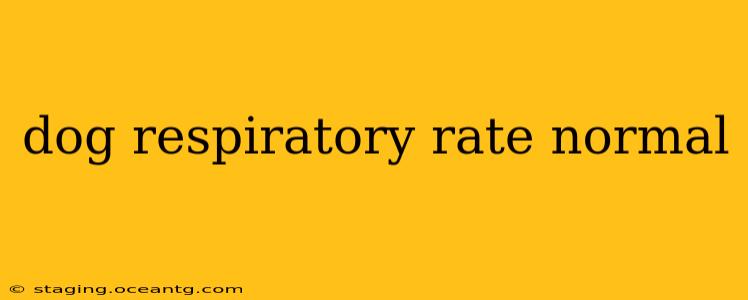Knowing your dog's normal respiratory rate is crucial for recognizing potential health problems. A change in breathing pattern can be an early warning sign of illness, so understanding what's considered normal and what might indicate a problem is vital for responsible pet ownership. This guide will help you understand your dog's respiratory system and how to monitor their breathing effectively.
What is a Normal Respiratory Rate for Dogs?
A dog's normal respiratory rate (RR) varies depending on factors like breed, age, size, and activity level. Generally, a healthy adult dog at rest will breathe between 10 and 30 breaths per minute. However, puppies and smaller breeds tend to have faster breathing rates than larger breeds or adult dogs. Excitement, exercise, and even stress can temporarily increase a dog's respiratory rate.
How to Count Your Dog's Breaths Per Minute
Accurately counting your dog's respiratory rate is important. Here's how to do it:
- Find a comfortable position: Your dog should be relaxed and calm. Avoid disturbing them.
- Observe their abdomen: It's easier to count breaths by watching the rise and fall of their abdomen rather than their chest.
- Count the breaths: Count the number of breaths (one inhale and one exhale) in 15 seconds.
- Multiply by four: Multiply this number by four to obtain the breaths per minute.
For example, if your dog takes 5 breaths in 15 seconds, their respiratory rate is approximately 20 breaths per minute (5 x 4 = 20).
What Factors Affect a Dog's Respiratory Rate?
Several factors can influence a dog's respiratory rate:
- Age: Puppies and senior dogs often have faster breathing rates than adult dogs.
- Breed: Smaller breeds tend to have faster breathing rates than larger breeds.
- Exercise: Physical activity significantly increases respiratory rate.
- Temperature: Hot weather can lead to increased breathing rate.
- Stress or excitement: Anxiety or excitement can also elevate respiratory rate.
- Underlying health conditions: Respiratory illness, heart conditions, and other medical issues can affect a dog's breathing.
What are the Signs of Abnormal Respiratory Rate in Dogs?
While a slightly elevated respiratory rate after exercise is normal, consistently high or low respiratory rates, coupled with other symptoms, can indicate a problem. Look out for:
- Rapid breathing (tachypnea): More than 30 breaths per minute.
- Slow breathing (bradypnea): Less than 10 breaths per minute.
- Labored breathing (dyspnea): Visible effort in breathing, including open-mouth breathing, extended abdomen, and noisy breathing.
- Cyanosis: Bluish discoloration of the gums indicating low oxygen levels.
- Coughing or wheezing: Indicates potential respiratory infection or inflammation.
When Should I Take My Dog to the Vet?
If you notice any significant changes in your dog's breathing pattern, such as consistently high or low respiratory rates, labored breathing, or other concerning symptoms, consult your veterinarian immediately. Early intervention is critical for successful treatment of respiratory issues. Don't hesitate to seek veterinary advice if you are unsure about your dog's breathing.
How often should I check my dog's breathing?
Regularly monitoring your dog's breathing, especially during their routine check-ups, is beneficial. However, there's no set frequency. It's advisable to observe your dog's breathing pattern during regular interactions and to immediately seek vet attention if abnormalities are observed.
What are some common causes of abnormal respiratory rate in dogs?
Several factors can lead to an abnormal respiratory rate, including but not limited to: heart conditions, pneumonia, bronchitis, collapsing trachea, and even anxiety. Only a veterinarian can diagnose the underlying cause.
Can I use a pet pulse oximeter to measure my dog’s respiratory rate?
While not directly measuring respiratory rate, a pet pulse oximeter measures blood oxygen saturation. Low oxygen levels (hypoxemia) often accompany abnormal respiratory rates, making it a valuable tool in assessing your dog's overall respiratory health. It's crucial to use the device correctly and consult your vet for interpretation.
Remember, this information is for educational purposes only and should not replace professional veterinary advice. Always consult your veterinarian for diagnosis and treatment of any health concerns. Regular veterinary checkups are essential for maintaining your dog's overall health and well-being.
